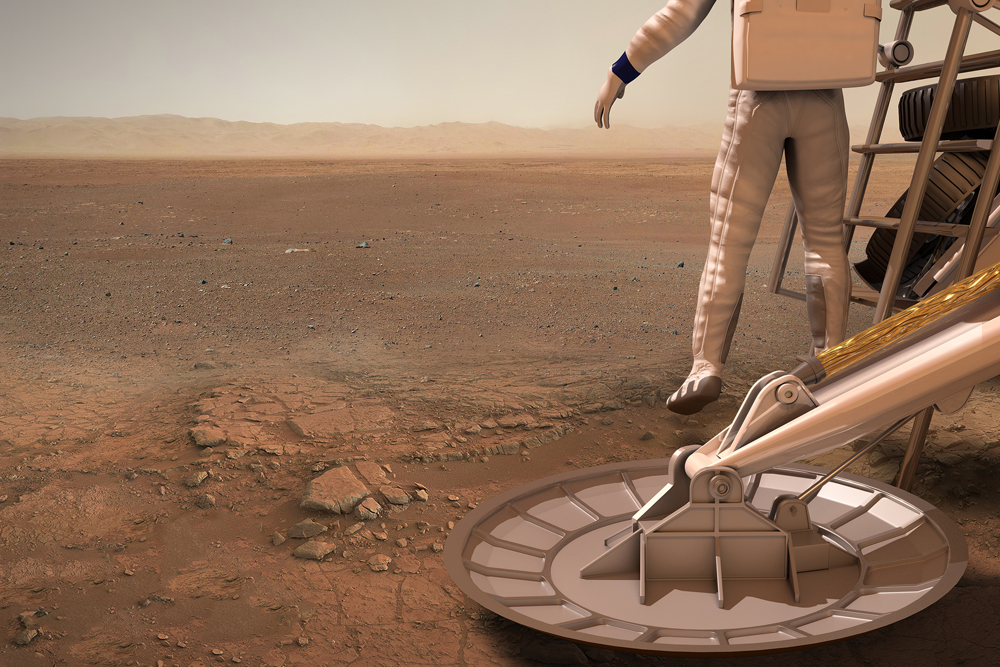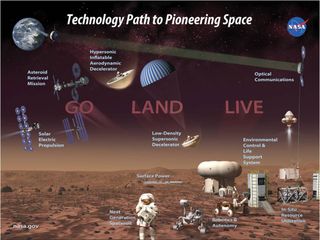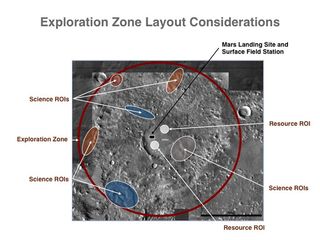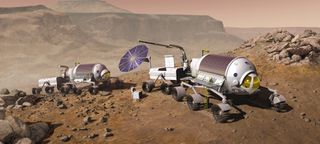Digging in on Mars! How Astronauts Will Survive and Thrive on the Red Planet

GOLDEN, Colo. — Establishing a permanent colony on Mars means living off the land.
Mars has usable resources such as water ice that could help sustain future expeditionary crews on short missions, or pioneers living permanently on the Red Planet, experts say.
"The use of local resources is pivotal for our future human exploration of Mars," said Angel Abbud-Madrid, director of the Center for Space Resources here at the Colorado School of Mines. [5 Manned Mars Mission Ideas]
"Either we bypass our reliance on them for an expensive, one-time trip carrying all needed supplies from Earth…or we incorporate resource utilization for a more affordable, multimission, and sustainable exploration of the Red Planet," Abbud-Madrid told Space.com.
But accessing and exploiting Martian water ice and other resources — a process known as In-Situ Resource Utilization (ISRU) — is easier said than done. So experts have begun to strategize what’s needed to allow astronauts to maintain a Martian lifestyle on the Red Planet.
Enabling element
ISRU was a topic of much discussion at NASA's First Landing Site/Exploration Zone Workshop for Human Missions to the Surface of Mars, which was held in October at the Lunar and Planetary Institute in Houston.
The meeting brought together planetary scientists and ISRU experts, Abbud-Madrid said, to work side-by-side as part of an extended effort to select the first landing site and exploration zone for humans on Mars.
Get the Space.com Newsletter
Breaking space news, the latest updates on rocket launches, skywatching events and more!
"This was not only a sign that NASA has decided to take an extended, multimission approach to explore the Red Planet, but also that Martian resources are now considered the 'enabling element' for a sustainable human exploration campaign," Abbud-Madrid told Space.com.
Nevertheless, by the end of the workshop, it was clear that further work needs to be done to get scientists and engineers to agree on the optimum landing site and exploration zone, "with both geologically interesting regions and with the necessary resources to establish a permanent human base," Abbud-Madrid said.
"On the one hand, scientific knowledge of the location and nature of local resources is needed to identify the optimum method to extract them," he said. "On the other hand, engineering knowledge of the extraction method is required to select the most appropriate deposit of resources. Realizing this interdependence is essential for the design of a successful human mission to Mars." [Giant Leaps: Top Milestones of Human Spaceflight]
Conversation has started
Choosing a human touchdown spot on Mars requires use of "embedded ISRU experts" working with landing site selection teams, said Jerry Sanders, ISRU chief engineer in the Propulsion and Power Division at NASA's Johnson Space Center in Houston.
"There is a need to understand that distance and ability to reach the resources are also important factors," Sanders told Space.com.
"The science and ISRU communities are making steps toward understanding each other's needs and goals…but there is still a ways to go," he said. "I am encouraged that the conversation has started."

Details still vague
NASA is committed to implementing ISRU on Mars, "but the details are still vague, and significant technology development will be required," said Robert Mueller, a senior technologist within the Science and Technology Projects Division at NASA's Kennedy Space Center in Florida.
Water and atmospheric carbon dioxide are anticipated to be the most valuable resources on Mars, Mueller said.
"These resources will provide propellants for the ride home on the Mars Ascent Vehicle (MAV) as well as [be] used for other critical uses such as life support, growing crops and radiation protection."
Mueller told Space.com that the selection of a Mars landing locale depends, in very large measure, on obtaining more data on what resources would be available at that site to sustain human life. Gathering added information is necessary, he said, "not only for one mission with a six-person crew, but rather a campaign of at least five missions with a long-term goal of having a permanent human presence on Mars."
Next-generation Mars orbiter
NASA has commissioned a team called the Next Orbiter Science Analysis Group — or NEX-SAG in space agency jargon — to analyze objectives for a possible next-generation Mars orbiter, Mueller said.
"If approved, this orbiter could be launched as early as 2022," he said. "One of the recommendations from this NEX-SAG team is to find resources on Mars to benefit future human missions."
This orbiter would likely carry dual-use instruments to "benefit science as well as resource prospecting," such as performing radar scans to look for subsurface pockets of ice and surveying key minerals, Mueller said. [Occupy Mars: History of Robotic Red Planet Missions (Infographic)]

Water is key
Not all local resources are equally important, Abbud-Madrid said.
"For production of propellants, radiation shielding, cooling of thermal systems, food production and last but not least, for human consumption, water is the most precious of them all," he said. "It turns out that because such large quantities of the vital liquid are needed for a sustainable operation of a human outpost, carrying that resource from Earth is not a viable option."
Although several types of water deposits on Mars have been identified, Abbud-Madrid said only two appear promising for ISRU purposes: subsurface ice/permafrost or water bound to rocks and fine-grained soil in the form of hydrated minerals, such as clays or gypsum.
Homework to be done
Nonetheless, Abbud-Madrid said that there is currently "no consensus" among scientists or ISRU experts regarding which type of water is the most desirable. They just don't have enough information yet.
"Accurately determining the source type, location, depth, distribution and purity of potential water deposits will be the homework for planetary scientists," Abbud-Madrid said. "Evaluating the most efficient techniques for excavating, beneficiating, extracting and purifying water from its various sources, as well as assessing the energy needed to perform these operations, remains on the to-do list for ISRU technologists."
Scientists and ISRU researchers alike will push for precursor missions to Mars, Abbud-Madrid added, to provide prospecting data from orbit, ground-based measurements and testing of extraction systems. Such work would verify the presence, quantity and optimum production method of water ahead of the first human Mars mission, which NASA hopes to launch in the 2030s.

Clear next step
David Stillman, a senior research scientist at the Southwest Research Institute in Boulder, Colorado, said he, too, took away some important messages from the October NASA meeting.
"The only resource NASA planners really cared about was water … so that they could make rocket fuel," Stillman told Space.com. "They would really like to find this water resource near the equator, and [they'd] only need 100 metric tons over a span of about 15 years."
Stillman said that there are a number of locations on Mars that could potentially serve up heaps of water. But the amount of energy required to extract water from what he sees as three possible sources — seasonal flows of water called recurring slope lineae (RSL), ice or hydrated minerals — has not been determined or studied.
"This is the clear next step," Stillman said.
Planetary protection concerns
All serious discussions of putting boots on Mars take into consideration planetary protection issues — the desire to avoid contaminating the Red Planet with Earth life (and vice versa, if Mars life exists).
"You cannot send a human mission to Mars without violating planetary protection," Stillman said.
"So either we need to send a precursor to the final landing site to determine if it has extant life, or we just ignore planetary protection in the name of exploration," he added.
Leonard David has been reporting on the space industry for more than five decades. He is former director of research for the National Commission on Space and is co-author of Buzz Aldrin's 2013 book "Mission to Mars – My Vision for Space Exploration" published by National Geographic with a new updated paperback version released in May 2015. Follow us @Spacedotcom, Facebook or Google+. Originally published on Space.com.
Join our Space Forums to keep talking space on the latest missions, night sky and more! And if you have a news tip, correction or comment, let us know at: community@space.com.

Leonard David is an award-winning space journalist who has been reporting on space activities for more than 50 years. Currently writing as Space.com's Space Insider Columnist among his other projects, Leonard has authored numerous books on space exploration, Mars missions and more, with his latest being "Moon Rush: The New Space Race" published in 2019 by National Geographic. He also wrote "Mars: Our Future on the Red Planet" released in 2016 by National Geographic. Leonard has served as a correspondent for SpaceNews, Scientific American and Aerospace America for the AIAA. He has received many awards, including the first Ordway Award for Sustained Excellence in Spaceflight History in 2015 at the AAS Wernher von Braun Memorial Symposium. You can find out Leonard's latest project at his website and on Twitter.